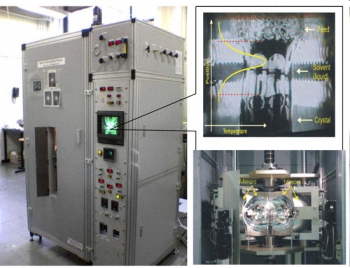Optical Foating Zone System

FZT-10000-H-VI-VP
To have access to good quality single crystals is crucial for studying physical and chemical properties in condensed matter. One of the main reasons is that in polycrystalline materials, the properties of the grain boundaries often manifest themselves stronger than the properties of the material itself. Large crystals of many materials can be grown by the floating zone technique. The principle of this technique is melting a small section of a feed rod with infrared radiation that has been focused by means of mirrors. Then the molten (floating) zone is translated along the sample length by moving the sample with respect to the radiation focus. The crystal is grown on the solidifying end of the float zone, on the seed, which should be a material with a similar crystal structure as the feed rod. Previous floating zone systems have employed single or double focusing mirrors. However, temperature distribution conditions around the horizontal plane have proven to be less than ideal. The new system employs 4 mirrors, which enables the growth of high quality single crystals by creating highly uniform and stable temperature distribution conditions.
Maximum operating temperature= 2200°C (typical operating temperature ~1800°C)
Maximum crystal growth length= 100 mm.
Growth speed= 0.18 ~ 18 mm/hr .
Rotation rate = 5 – 60 rpm.
Maximum atmospheric gas pressure = 9.5 atm.
